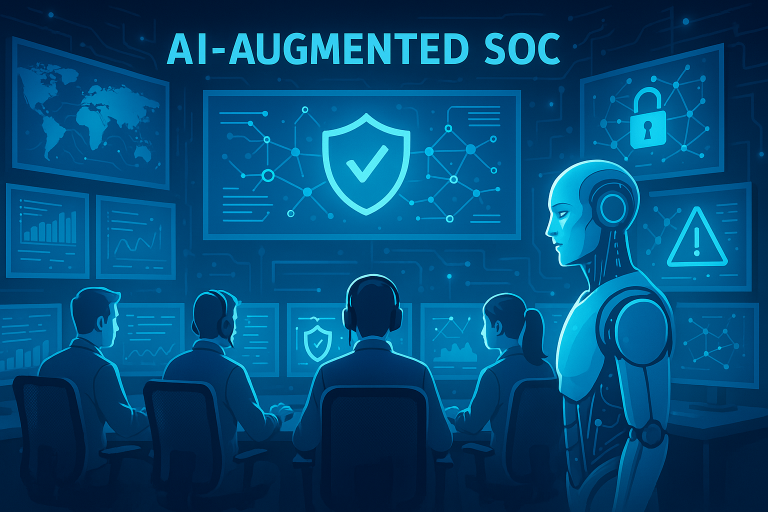
Status: Summary Blueprint
Author: Shahab Al Yamin Chawdhury
Organization: Principal Architect & Consultant Group
Research Date: March 16, 2024
Version: 1.0
1. The Imperative for Change: The Failing Traditional SOC
The traditional, human-centric Security Operations Center (SOC) is operationally and financially unsustainable. It is defined by a reactive “firefighting” model that cannot cope with the volume and sophistication of modern cyber threats. This leads to a vicious cycle of increasing risk and declining performance, driven by four interconnected systemic failures:
- Alert Fatigue: Analysts are overwhelmed by thousands of low-fidelity alerts from noisy, rule-based tools, leading to critical threats being missed.
- Manual Inefficiency: Investigations are slow and error-prone, requiring analysts to manually pivot between dozens of disconnected security tools, dramatically increasing response times (MTTR).
- Cybersecurity Skills Shortage: A global talent shortage is worsened by high rates of analyst burnout and turnover, making it impossible to adequately staff a manual SOC.
- Fragmented Technology: A patchwork of siloed security products prevents a unified view of risk and is complex and costly to maintain.
2. The Solution: The SOC 3.0 Proactive Paradigm
SOC 3.0 is a fundamental reimagining of security operations, shifting the focus from reacting to threats to proactively anticipating and neutralizing them. This AI-augmented model is built on three core pillars:
- Proactive Threat Hunting: Moving beyond passive alert monitoring to actively and continuously search for hidden threats that have evaded automated defenses, with AI scaling this function by identifying high-probability leads.
- Predictive Analytics: Using AI/ML to analyze historical data, threat intelligence, and organizational vulnerabilities to forecast where future attacks are most likely to occur and preemptively harden defenses.
- Autonomous Response: Leveraging AI-driven hyperautomation to autonomously investigate and remediate the vast majority of routine security incidents, freeing human experts to focus on the most critical and novel threats.
SOC Generations at a Glance
| Characteristic | SOC 1.0 (Manual) | SOC 2.0 (Automated) | SOC 3.0 (AI-Augmented) |
| Core Philosophy | Detect & Respond | Enrich & Automate | Predict & Prevent |
| Primary Technology | SIEM | SIEM + SOAR | AI-Native Analytics Platform |
| Operational Posture | Reactive | Reactive with Automation | Proactive & Predictive |
| Analyst Role | Alert Responder | Playbook Operator | Threat Hunter / AI Supervisor |
3. Core Technology & Architecture
The SOC 3.0 architecture is a decentralized, intelligent ecosystem built around an AI control plane, moving beyond the monolithic, centralized SIEM of the past.
- AI-Native Security Analytics (Next-Gen SIEM): The core engine, embedding AI/ML for high-fidelity behavioral anomaly detection and threat prediction.
- Extended Detection & Response (XDR): Provides unified visibility by collecting and correlating telemetry from endpoints, network, cloud, and identity systems into a single incident view.
- User & Entity Behavior Analytics (UEBA): A core capability that detects insider threats and compromised accounts by baselining normal activity and identifying anomalous deviations.
- AI-Enhanced SOAR: The action layer, using AI to execute dynamic, context-aware automated responses, moving beyond rigid, pre-scripted playbooks.
- Federated Security Data Lake: A flexible, cost-effective approach to data management that allows the AI engine to query data where it lives, avoiding costly data duplication.
4. Phased Implementation Roadmap
A successful transformation requires a structured, four-phase approach to manage risk, demonstrate value, and adapt organizational culture.
| Phase | Timeline | Key Objectives | Success Metrics |
| 1. Foundation | Months 1-3 | Establish baseline, define goals, build business case. | C-level approval of roadmap. |
| 2. Pilot | Months 4-9 | Prove value with 1-2 pilot use cases, gather feedback. | Pilot KPIs exceed baseline (e.g., 50% faster triage). |
| 3. Expansion | Months 10-18 | Scale capabilities, decommission legacy tools, upskill team. | 75% of alerts triaged by AI, MTTR reduced by 60%. |
| 4. Autonomy | Months 19+ | Maximize autonomy, shift focus to proactive defense. | 90%+ of Tier-1 incidents handled autonomously. |
5. Measuring Success: Key Performance Indicators (KPIs)
Performance measurement must shift from volume-based metrics to those that quantify efficiency, accuracy, and business value.
| Metric Category | KPI | Target Benchmark |
| AI Efficiency | Alert Escalation Rate | < 5% |
| Mean Time to Investigate (by AI) | < 3 minutes | |
| Operational Impact | Mean Time to Detect (MTTD) | < 1 hour |
| Mean Time to Respond (MTTR) | < 15 minutes | |
| Business Value | Analyst Time on Threat Hunting | > 30% |
| Breach Likelihood Reduction | > 35% |
6. The Human Element & The Future
The transition to SOC 3.0 elevates the human analyst from a reactive ticket processor to a strategic, AI-augmented role, such as Threat Hunter, Detection Engineer, or Automation Engineer. This requires a focus on upskilling, as well as robust AI governance to manage risks like adversarial attacks and ensure model transparency through Explainable AI (XAI).
The journey prepares the enterprise for the next frontier, SOC 4.0, which will be defined by a true human-machine symbiosis, hyper-automation of the entire security lifecycle, and machine-speed “AI vs. AI” warfare.